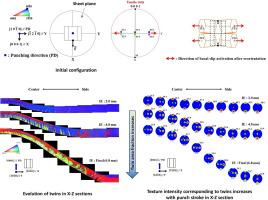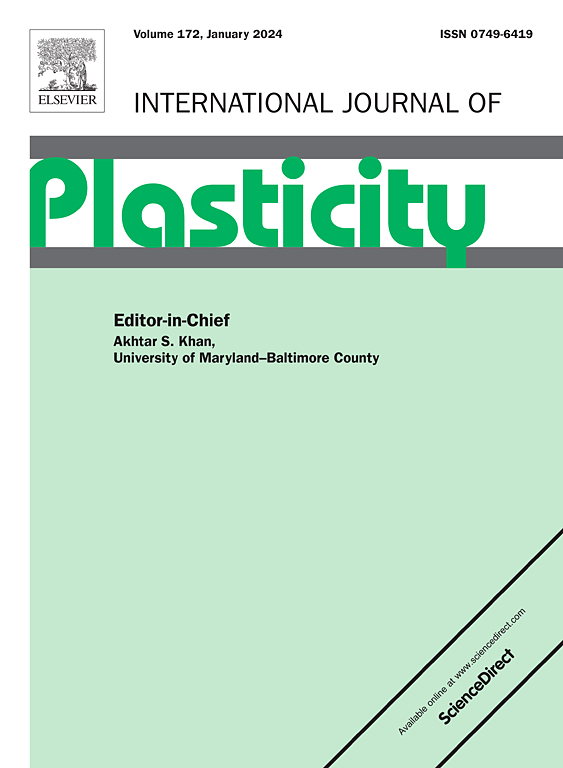Deformation mechanisms in pure Mg single crystal under erichsen test: Experimental observations and crystal plasticity predictions
IF 12.8
1区 材料科学
Q1 ENGINEERING, MECHANICAL
引用次数: 0
Abstract
In the present study, the deformation mechanisms in a pure Mg single crystal deformed under the Erichsen test were investigated. The specimens were deformed for different punch strokes under a given crystallographic orientation relationship with respect to the punch direction at room temperature (RT). The electron backscattered diffraction (EBSD) technique was used for the microstructural study of the deformed specimens. The analysis showed that thin twin bands (TBs), consisting of several twin variants, were heterogeneously generated throughout the specimens. In particular, the specimen with the highest Erichsen Index (IE) value of 6.8 mm showed the most significant twinning activity throughout the thickness. The high stretch formability in the given crystallographic orientation is achieved due to the significant tensile twinning activity, which generates a favorable crystal orientation for the activation of basal slip under subsequent deformation. Furthermore, the crystal plasticity finite element method (CPFEM) was used to elucidate the heterogeneity observed during the experimental analysis by studying the strain component generated, the relative activity of different deformation modes, and the accumulated volume fraction of different twinning variants.


Erichsen试验下纯Mg单晶的变形机制:实验观察和晶体塑性预测
本文研究了纯Mg单晶在Erichsen试验下变形的机理。在室温(RT)条件下,在给定的晶体取向关系下,对试样进行不同冲孔行程的变形。利用电子背散射衍射(EBSD)技术对变形试样进行了显微组织研究。分析表明,由多个孪晶变体组成的薄孪晶带(TBs)在整个试样中呈非均匀分布。其中,Erichsen指数(IE)最高为6.8 mm的试件在整个厚度范围内孪晶活性最为显著。在给定的晶体取向下,高拉伸成形性是由于显著的拉伸孪晶活性,这为后续变形下基底滑移的激活产生了有利的晶体取向。此外,采用晶体塑性有限元法(CPFEM)对实验分析过程中观察到的非均匀性进行了分析,研究了不同变形模式产生的应变分量、不同变形模式的相对活度以及不同孪晶变体的累积体积分数。
本文章由计算机程序翻译,如有差异,请以英文原文为准。
求助全文
约1分钟内获得全文
求助全文
来源期刊

International Journal of Plasticity
工程技术-材料科学:综合
CiteScore
15.30
自引率
26.50%
发文量
256
审稿时长
46 days
期刊介绍:
International Journal of Plasticity aims to present original research encompassing all facets of plastic deformation, damage, and fracture behavior in both isotropic and anisotropic solids. This includes exploring the thermodynamics of plasticity and fracture, continuum theory, and macroscopic as well as microscopic phenomena.
Topics of interest span the plastic behavior of single crystals and polycrystalline metals, ceramics, rocks, soils, composites, nanocrystalline and microelectronics materials, shape memory alloys, ferroelectric ceramics, thin films, and polymers. Additionally, the journal covers plasticity aspects of failure and fracture mechanics. Contributions involving significant experimental, numerical, or theoretical advancements that enhance the understanding of the plastic behavior of solids are particularly valued. Papers addressing the modeling of finite nonlinear elastic deformation, bearing similarities to the modeling of plastic deformation, are also welcomed.
 求助内容:
求助内容: 应助结果提醒方式:
应助结果提醒方式:


